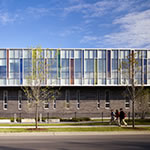Toward the completion of the Sarah E. Goode STEM Academy, STR Partners, the building’s lead architect, realized that the project was just a point shy of LEED Platinum certification. “[Green power] was kind of a cheap point, but it got us there,” says Colby Lewis, a management partner at STR Partners, referring to the fact that the credit in question can be purchased rather than designed into the building. “But we don’t feel bad because we got nine out of ten energy credits.” A LEED charette, plus close collaboration with Nia Architects and FH Paschen, helped the team surpass its goal of LEED Silver and resulted in a building and site that serve as a model of sustainable design for both students and the community. The team took us on a tour to point out the school’s numerous innovations.

The reading garden, with plantings interspersed with seating areas, requires no irrigation, helping the school achieve a 40% reduction in water use.
Open Spaces, Growing Places
Located on Chicago’s southwest side, on a brownfield found to have underground storage tanks and subsequent leakage, the site is surrounded by residential neighborhoods on both its west and south sides. The goal, as a result, was “to provide not only a school, but an amenity the whole community could benefit from,” Lewis says. In order to make sustainable design accessible to both students and residents, the team included numerous open spaces, including walking paths, a community garden, a learning garden, and two rain gardens for storm-water control. Near the building’s cafeteria, where the community garden and outdoor seating are situated, one rain garden can be viewed from inside. “The thought was that the students can see where their food is coming from,” Lewis says.

The academy’s site in southwest Chicago is a former brownfield. The LEED Platinum high school will serve as a prototype for future Chicago schools.
An Unequaled Environment
The architects brought daylight into the core learning spaces by enlarging windows and adding occupancy sensors and dimming features. This allowed for daylight-harvesting. “LEED Platinum for Chicago schools is an investment in the children’s lives in that it creates an environment that is conducive to learning and provides a healthy indoor air quality,” says Anthony Akindele, a principal at Nia Architects, who adds that such environments have been shown to reduce absenteeism. “It saves a lot of dollars from an energy standpoint, and it invokes curiosity on the part of children.” Although there is a perception that green building leads to limitations, Daryl Lesny, the project manager for FH Paschen, says this school proves otherwise. “It’s more like a college campus than a high school or academy,” he says. “It’s a beautiful, state-of-the-art building. You don’t need to sacrifice to get to this level.”

To capture rainwater, STR Architects designed a sculptural cistern that allows water to cascade from ‘petal’ to ‘petal.’
Rooftop Sanctuary
The building is divided into three parts: “mind” (classrooms), “body” (physical education facilities) and “spirit” (music and art spaces and the library). Comprising roughly 50 percent of its site, the building has two green roofs: one located above the library and arts area, and the second located over the gym and natatorium. The latter is the larger of the two and was developed as a bird sanctuary. Depressions hold water, and vegetation—including low-maintenance, weather-tolerant sedums as well as branches and stumps from trees that were removed to build the school—holds insects for the birds to feed on.

The gym includes retractable bleacher seating and a raised stage for performances with built-in high-efficiency lighting, rigging, and an acoustical system.
Poolside Design
The natatorium’s unique back-flush system uses a regenerative media filter to reduce water waste by thousands of gallons. “As compared to the more widely used high-rate pressure sand filter, this can save up to 195,000 gallons of water each year,” says Jennifer Costanzo, operations partner at STR Partners. Nineteen roof-mounted, evacuated tube collectors heat the pool water with renewable energy; additional heating from the panels is used for the domestic water system. “This was a new system that we hadn’t seen,” Lesny says. “So there was a little more effort put toward that to get everything installed correctly and working properly.”

With patterned tile and a band of windows to bring in sunlight, the pool uses a regenerative media filter that saves 195,000 gallons of water annually. The blue ceiling represents a summer sky.
Energy and Cost Savings
Reducing HVAC operating energy by an estimated 20 percent, a ground-source heat pump system is the only one of its kind in Chicago Public Schools. Composed of a 174-well geothermal exchange system, which is combined with heat pumps located in each classroom, the system offers significant savings. “We saved an average of $7 million in installation costs,” Costanzo says.
See more photos below.



